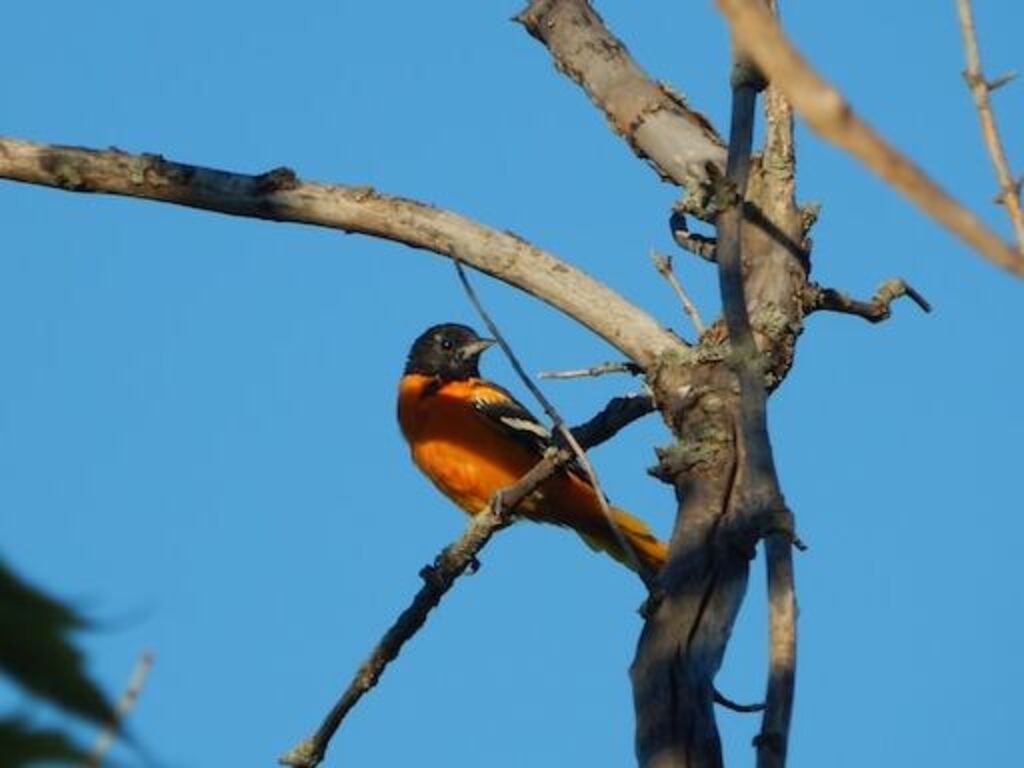Grape news, folks! Today, we dive into the quirky culinary adventures of our feathered friends. So, you might be wondering, “Do Baltimore Orioles eat grapes?” Well, the short answer is, yes, they do!
But hold on to your vineyards because there’s more to this fruity feast than meets the eye. Discover why these vibrant birds have a soft spot for grapes and unravel the juicy details in this tantalizing article.
Table of Contents
- 1 Do Baltimore Orioles Eat Grapes?
- 2 Overview of the Baltimore Oriole’s Diet
- 3 Insect Consumption
- 4 Nectar Consumption
- 5 Fruit Consumption
- 6 Grape Consumption
- 7 Other Foods They May Eat
- 8 Importance of Diet for Orioles
- 9 Final Thoughts on Orioles and Grapes
- 10 Frequently Asked Questions
- 10.1 What is the average lifespan of a Baltimore Oriole?
- 10.2 How do Baltimore Orioles communicate with each other?
- 10.3 What is the mating season for Baltimore Orioles?
- 10.4 What are the predators of Baltimore Orioles?
- 10.5 How do Baltimore Orioles migrate, and where do they go during the winter months?
- 11 Conclusion
- 12 Author
Do Baltimore Orioles Eat Grapes?
Baltimore Orioles do indeed eat grapes, among other fruits. While they primarily feed on nectar, insects, and spiders, these vibrant birds have been known to enjoy the sweet and juicy offerings of grapes.
Their varied diet includes a range of fruits, providing them with essential nutrients and hydration.
So, if you have a grapevine in your backyard, don’t be surprised to see these delightful Orioles adding a fruity twist to their menu!
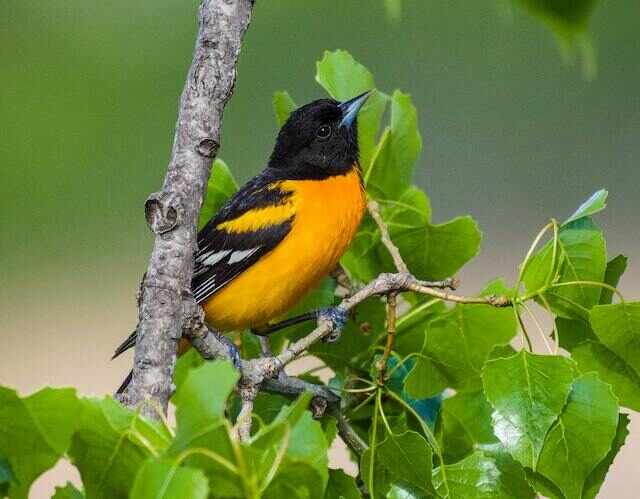
Overview of the Baltimore Oriole’s Diet
The Baltimore Oriole’s diet is diverse and includes a range of insects, fruits, and nectar, reflecting the species’ adaptability and ability to thrive in various environments.
Diet diversity is particularly important for migratory birds like the Baltimore Oriole, as it allows them to find food sources in different locations along their migration route.
The species primarily feeds on insects during the breeding season, consuming ants, beetles, caterpillars, and other arthropods.
In the non-breeding season, they switch to a diet that includes fruit and nectar, particularly from oranges, grape jelly, and other sugary sources.
Overall, the Baltimore Oriole’s ability to consume a variety of foods makes it a successful species, able to adapt and thrive in different habitats.
Next, we will explore the Baltimore Oriole’s insect consumption.
Insect Consumption
Baltimore orioles are known to consume a wide variety of insects as a crucial part of their diet.
Some of the common insects that they feed on include caterpillars, beetles, ants, and moths.
Insects are an important source of protein and other nutrients for these birds, especially during the breeding season when they require more energy for mating and nesting.
Types of Insects They Eat
Insect ingestion is an integral aspect of the Baltimore Oriole’s dietary habits. These birds have a diverse palate and consume a wide variety of insects, including beetles, caterpillars, ants, spiders, and grasshoppers.
Their insect consumption varies throughout the year, with a preference for caterpillars during the breeding season and a shift towards beetles in the fall.
Baltimore Orioles also consume insects at different stages of development, including larvae and pupae.
Insects are an important source of protein and other nutrients for these birds, which is crucial for their growth, development, and survival.
Understanding the types of insects Baltimore Orioles consume and how their preferences change with the seasons can provide critical insights into their ecology and behavior.
The importance of insects in their diet extends beyond mere sustenance, as it can also influence their foraging strategies, habitat selection, and interactions with other species.
Importance of Insects in Their Diet
Exploring the significance of insects in the Baltimore Oriole’s diet can shed light on their ecological and behavioral patterns, as well as provide a clear understanding of the role of insects in their survival and development.
Insects play a vital role in the ecosystem as they are a crucial food source for many species, including the Baltimore Oriole.
As insectivorous birds, Baltimore Orioles rely heavily on insects during their breeding season, as they provide the necessary nutrients for the growth and development of their young.
Moreover, the consumption of insects also has a significant impact on the behavior of the birds, as it influences their migration patterns, foraging strategies, and mate selection.
However, the impact of climate change on insects may have severe consequences for Baltimore Orioles, as changes in temperature and precipitation patterns can alter the abundance and distribution of insect populations, ultimately affecting the birds’ survival.
The study of the role of insects in the Baltimore Oriole’s diet is, therefore, essential for understanding the intricate relationships between species in the ecosystem and for predicting the effects of environmental change on the bird populations.
Moving on to nectar consumption, Baltimore Orioles also rely on this sweet liquid as an important source of energy.

Nectar Consumption
Baltimore Orioles are known to consume nectar as a part of their diet. They prefer nectar from certain flowers, such as trumpet vines, jewelweed, and cardinal flowers.
Nectar provides the necessary energy for their active lifestyle and aids in their migration.
In this subtopic, we will discuss the flowers that Baltimore Orioles prefer and the benefits of nectar in their diet.
Flowers They Prefer
Flowers are the preferred food source for the Baltimore Oriole. These birds have specific preferences when it comes to the types of flowers they consume.
Some popular flowers that they tend to favor include trumpet vines, red columbine, bee balm, and cardinal flowers. Additionally, they tend to prefer flowers that are bright orange or red in color.
The Baltimore Oriole has a particular fondness for nectar-rich flowers, which provide them with the necessary energy to sustain their active lifestyle.
Plant preferences vary from individual to individual, but the Baltimore Oriole generally likes to feed on flowers that are native to their habitat.
As a result, it is recommended to plant native flowers in your garden to attract these birds.
Incorporating these plants into your landscape can provide a valuable food source for the Baltimore Oriole while simultaneously beautifying your outdoor space.
The benefits of nectar in their diet go beyond providing sustenance. Nectar is also a crucial source of hydration for these birds, especially during hot and dry weather conditions.
Benefits of Nectar in Their Diet
The inclusion of nectar-rich flowers in the Baltimore Oriole’s diet provides essential sustenance and hydration during hot and dry weather.
Nectar is a vital source of carbohydrates, which provide energy for the orioles to sustain their daily activities.
In addition to this, nectar is also rich in vitamins and minerals that are beneficial to the orioles’ health.
The role of nectar in oriole migration cannot be overstated, as it plays a significant role in fueling the birds’ long-distance flights.
The nectar from flowers is an essential source of energy for the orioles during their migration. Oriole species that rely on nectar-rich flowers for sustenance are known to fly longer distances without stopping.
The benefits of nectar in the orioles’ diet are undeniable, and it is crucial for their survival. The subsequent section will delve into the orioles’ fruit consumption, which is just as crucial for their health and survival.
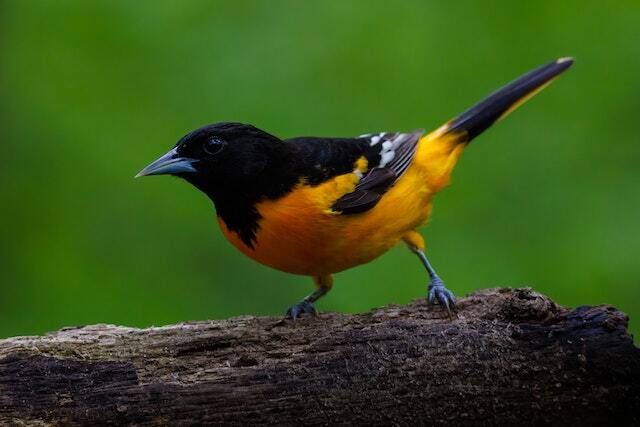
Fruit Consumption
According to research on the dietary habits of certain avian species, fruit consumption is an important aspect of their overall nutritional intake.
This holds true for Baltimore Orioles, who have been observed to have a preference for fruits such as oranges, berries, and cherries.
In fact, fruits make up a significant portion of their diet, alongside nectar and insects. Incorporating fruit into their diet provides Orioles with dietary variety, which is important for maintaining their health.
While there is no conclusive evidence that Baltimore Orioles eat grapes, it is possible that they may consume them if available.
Understanding the fruit preferences of these birds can help conservationists and bird enthusiasts provide appropriate food sources for them, allowing them to thrive in their natural habitats.
Grape Consumption
Certain avian species show a strong inclination towards fruit consumption, suggesting its importance in their diet.
While not conclusively proven, it is plausible that Baltimore Orioles may include grapes in their fruit preferences, alongside other favorites like oranges, berries, and cherries.
The grape varieties found in the wild are often small, tart, and seedy, making them less attractive to birds.
However, with modern grape farming techniques, farmers have been able to produce larger, sweeter grapes that may be more appealing to birds.
It is possible that Baltimore Orioles may consume these types of grapes if they are available in their habitat.
Other foods that Baltimore Orioles may eat include insects, nectar, and seeds.
It is important to note that their diet may vary depending on factors such as season and availability of food sources.
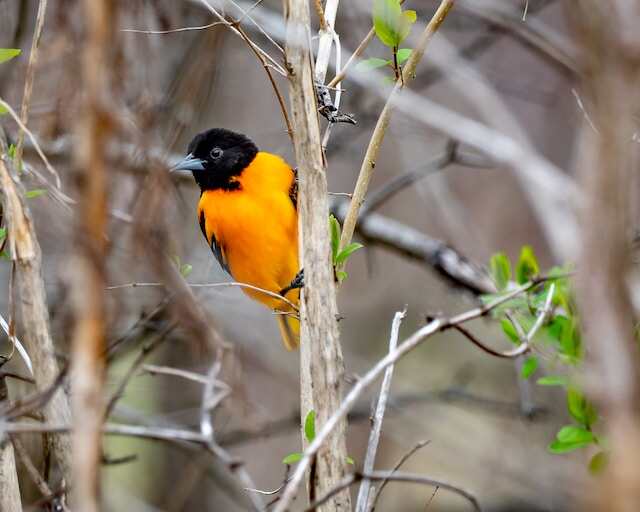
Other Foods They May Eat
Exploring the dietary habits of avian species, it is evident that Baltimore Orioles may incorporate a variety of foods into their nutritional intake, such as insects, nectar, and seeds, which may vary depending on seasonal and food source availability factors.
Alternative fruits, such as apples, berries, and oranges, may also be included in their diet. Their seed preferences include sunflower, millet, and safflower seeds.
The impact of seasonal changes may affect their food selection, as they may consume more insects during the breeding season and switch to a greater seed and fruit diet during migration and winter.
Understanding the importance of proper nutrition for orioles can lead to a better understanding of their behavior and health.
Importance of Diet for Orioles
The nutritional intake of avian species, including Baltimore Orioles, is crucial to their behavior and health, highlighting the importance of understanding the impact of seasonal changes on their diet.
Orioles require a varied diet to fulfill their nutritional needs for proper growth and development. A balanced diet ensures that they are getting the necessary vitamins and minerals required for their survival.
Orioles are opportunistic feeders, meaning they feed on a wide variety of fruits, insects, and nectar.
Their diet choices are influenced by their habitat, as they tend to consume food that is readily available in their surroundings.
For instance, during the breeding season, when protein is essential for the growth of their young, they tend to consume more insects.
Orioles also prefer nectar-rich flowers during the migration season, when they need to build up their fat reserves for the long journey ahead.
In summary, the benefits of a varied diet for orioles cannot be overstated. It is essential to understand the impact of habitat on their diet choices to ensure their continued survival.
Moving on to the next section, let’s explore some final thoughts on orioles and grapes.
Final Thoughts on Orioles and Grapes
Understanding the relationship between avian species and their diet choices, particularly in regards to the consumption of grapes, can provide valuable insight into their behavior and ultimately contribute to their overall conservation.
When it comes to Baltimore Orioles, grape consumption can have a number of benefits. Grapes are a rich source of antioxidants, which can help to protect the birds from damage caused by free radicals.
Additionally, grapes are high in sugar, which provides the orioles with a quick burst of energy that can be especially important during migration.
However, there are also potential risks associated with grape consumption for orioles. Grapes can be difficult for birds to digest and can potentially cause gastrointestinal issues.
Additionally, grapes that have been treated with pesticides can be toxic to birds.
Overall, while grapes can be a beneficial addition to the diet of Baltimore orioles, it is important to ensure that they are consumed in moderation and that any grapes offered are free from harmful chemicals.
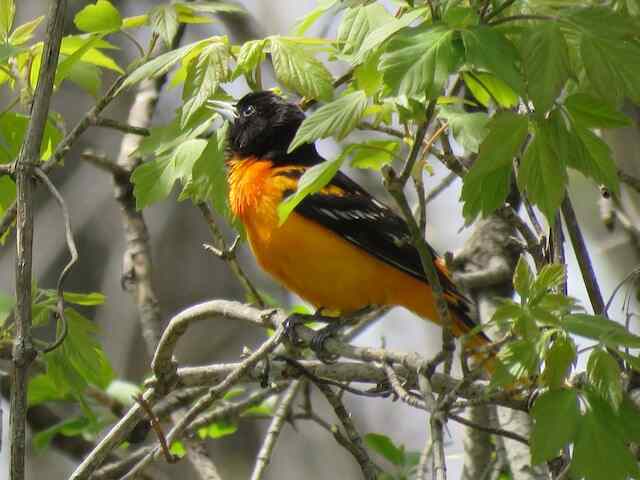
Frequently Asked Questions
What is the average lifespan of a Baltimore Oriole?
As the bright orange plumage of the Baltimore Oriole catches the eye, one might wonder about the average lifespan of this stunning bird.
The Baltimore Oriole has an average lifespan of 6-8 years in the wild, but can live up to 12 years in captivity.
These birds are commonly found in deciduous forests, orchards, and suburban areas of eastern North America, where they build intricate nests.
Baltimore Orioles are migratory birds, spending their winters in Central and South America.
Their migration patterns take them through the Gulf of Mexico, where they may rest and refuel before continuing their journey.
In terms of dietary habits and food sources, Baltimore Orioles primarily feed on insects, but also enjoy fruits such as mulberries, cherries, and oranges.
While there is not much evidence to suggest that Baltimore Orioles eat grapes specifically, it is not impossible.
As the saying goes, variety is the spice of life, and these birds certainly enjoy a diverse diet.
How do Baltimore Orioles communicate with each other?
Baltimore Orioles communicate with each other through a combination of vocalizations and body language.
They use a variety of calls and songs to convey different messages, such as warning others of potential predators or identifying themselves to potential mates.
In addition to vocalizations, Baltimore Orioles also use body language, such as wing flapping and tail flicking, to communicate with each other.
They are social birds and often engage in communal activities, such as nesting and foraging.
Their nesting habits are also a form of social behavior, as they often build their nests in close proximity to other orioles.
Overall, vocalizations, body language, social behavior, and nesting habits all play important roles in the communication and social interactions of Baltimore Orioles.
What is the mating season for Baltimore Orioles?
The mating season for Baltimore Orioles typically occurs during late May to early July. During this time, males will perform elaborate courtship displays to attract potential mates.
Once a mate is selected, the pair will build a nest together using various materials such as grass, string, and hair.
The female will lay between 3-7 eggs, which both parents will take turns incubating for around 12-14 days.
After hatching, the chicks will stay in the nest for around 11-14 days before fledging.
It is important to note that while Baltimore Orioles are primarily insectivorous, they may occasionally consume fruit such as berries, but there is no evidence to suggest they eat grapes specifically.
Understanding the mating habits and nesting behaviors of Baltimore Orioles can provide valuable insight into their reproductive success and overall population dynamics.
What are the predators of Baltimore Orioles?
Baltimore Orioles are small, brightly colored birds that are popular among bird enthusiasts. While they are known for their beautiful plumage and sweet song, they are also vulnerable to a number of predators in the wild.
Some of the most common predators of Baltimore Orioles include snakes, hawks, and domestic cats.
These predators are attracted to the birds because of their small size and colorful plumage, making them easy targets.
Bird feeding stations can also attract predators, so it is important to keep them clean and well-maintained to ensure the safety of the birds.
While Baltimore Orioles are known to eat a variety of foods, including insects, nectar, and fruit, there is no evidence to suggest that they regularly consume grapes.
How do Baltimore Orioles migrate, and where do they go during the winter months?
Baltimore Orioles are migratory birds that breed in North America and fly south for the winter. During migration, their diet largely consists of insects, nectar, and fruits. However, their diet may vary depending on their location and availability of food.
In the winter months, Baltimore Orioles prefer to inhabit tropical and subtropical regions with a high concentration of fruit-bearing trees. They can be found in countries such as Mexico, Central America, and South America.
These birds have a unique migration pattern where they follow a clockwise loop, flying from eastern North America to the Gulf of Mexico, then across the Gulf to Mexico and Central America, and finally returning northward via the West Indies.
Understanding the Baltimore Orioles’ diet during migration and habitat preferences during winter months is essential for conservation efforts and ensuring the survival of these beautiful birds.
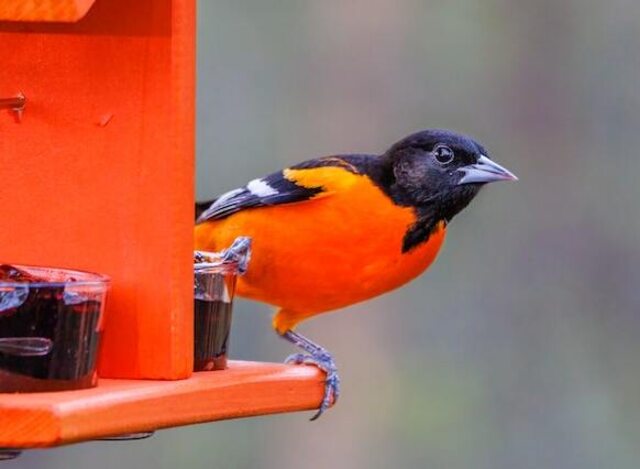
Conclusion
The Baltimore Oriole’s diet primarily comprises insects, nectar, and fruits. They are known to consume a wide range of fruits, including oranges, berries, and cherries.
However, grapes are not a significant part of their diet. While they may occasionally consume grapes, it is not a staple food for them.
Apart from fruits, Orioles also feed on insects such as caterpillars, grasshoppers, and spiders. Additionally, they have a sweet tooth and are attracted to nectar from flowers like trumpet creeper and jewelweed.
A balanced and diverse diet is crucial for the Orioles’ health and survival.
In conclusion, while Baltimore Orioles may eat grapes, it is not a significant part of their diet. They primarily feed on insects, nectar, and a variety of fruits.
It is essential to understand the dietary habits of these birds, as a balanced diet is crucial for their well-being and survival.
As poet John Keats once said, ‘Beauty is truth, truth beauty.’ The truth about the Baltimore Oriole’s diet is not only informative but also adds to the beauty and wonder of the natural world.

